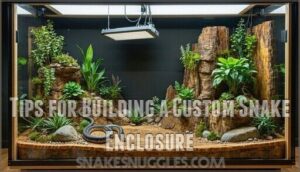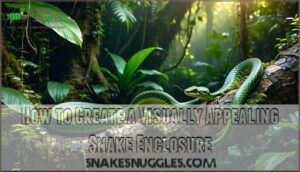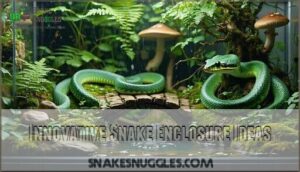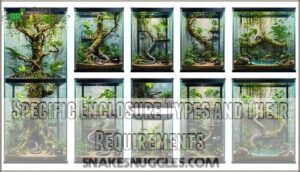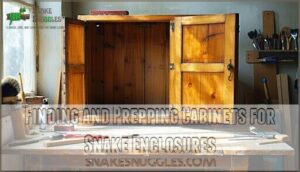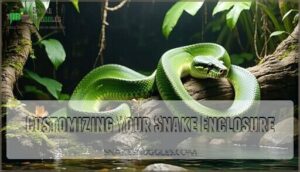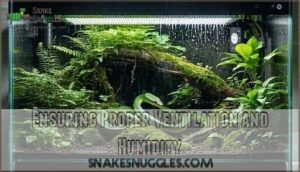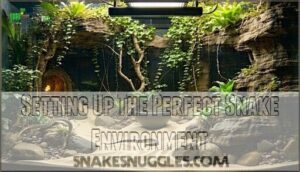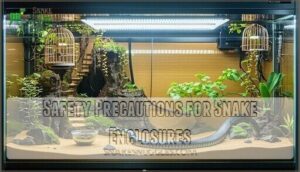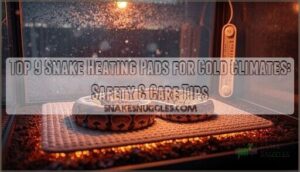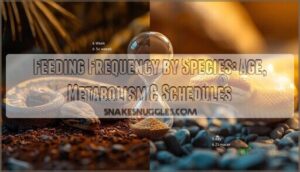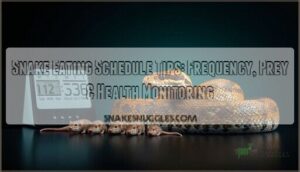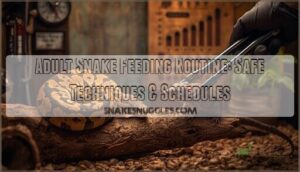This site is supported by our readers. We may earn a commission, at no cost to you, if you purchase through links.
 You’ll find the best snake enclosure ideas combine safety, comfort, and natural appeal.
You’ll find the best snake enclosure ideas combine safety, comfort, and natural appeal.
Start with solid materials like melamine or PVC for durability and easy cleaning.
Glass terrariums work well for smaller species, while custom wooden cabinets offer more space for larger snakes.
Include proper ventilation, heating elements, and secure locks to prevent escapes.
Add hiding spots, climbing branches, and substrate that mimics your snake’s natural habitat.
Temperature gradients are essential – create warm and cool zones using heat mats or ceramic heaters.
The right enclosure setup can transform basic housing into a stunning display that keeps your snake healthy and stress-free while showcasing their beauty.
Table Of Contents
- Key Takeaways
- Choosing The Right Enclosure
- Designing The Perfect Snake Enclosure
- Building a Snake Enclosure
- Customizing Your Snake Enclosure
- Ensuring Proper Ventilation and Humidity
- Setting Up The Perfect Snake Environment
- Safety Precautions for Snake Enclosures
- Introducing Your Snake to Its New Home
- Frequently Asked Questions (FAQs)
- Can you build a DIY snake enclosure?
- What makes a good snake enclosure?
- How do you secure a snake enclosure?
- What is a DIY snake cage enclosure?
- How do I choose the best room for a snake enclosure?
- Should a snake enclosure be placed in a living area?
- What type of enclosure is best for snakes?
- What not to put in a snake enclosure?
- Do snakes like being in enclosures?
- What type of enclosure is best for a snake?
- Conclusion
Key Takeaways
- Choose durable materials – You’ll want PVC, melamine, or glass over pine/cedar, which release toxic compounds that harm your snake’s respiratory system.
- Create proper temperature zones – You need to establish warm basking areas (85°F) and cool zones (75°F) using heat mats or ceramic heaters for your snake’s thermoregulation.
- Install secure ventilation systems – You must add mesh panels or adjustable vents to prevent dangerous mold growth while maintaining healthy humidity levels.
- Focus on escape-proof security – You’ll need strong latches, sealed seams with aquarium-safe silicone, and secure locks to prevent your snake from escaping its enclosure.
Choosing The Right Enclosure
You’ll want to choose materials that create a safe, durable home for your snake while fitting your budget and skill level.
The right enclosure materials can make the difference between a thriving snake and costly problems down the road.
Suitable Materials for Snake Enclosures
Why struggle with unsuitable materials when the right choice makes all the difference?
Glass provides easy cleaning for smaller snakes, while plastic offers budget-friendly durability perfect for DIY projects.
Melamine benefits include superior moisture resistance for custom builds. Plywood delivers cost-effective strength, and various substrate options enhance comfort.
Each material serves specific needs—glass for visibility, plastic for affordability, melamine for longevity.
Consider also the options for a suitable habitat setup.
Choose materials that match your snake’s requirements and your building skills.
Materials to Avoid for Snake Enclosures
Several materials pose serious health risks to your snake and should be completely avoided when building an enclosure.
Aromatic Woods like pine and cedar release toxic compounds that damage respiratory systems. MDF and craftwood create harmful dust particles. Unsealed Wood allows bacteria growth and moisture damage. Sharp Edges from rough materials can injure your snake. Painted surfaces and Toxic Adhesives contain chemicals that off-gas dangerous fumes. Porous Materials trap contaminants and become breeding grounds for harmful bacteria.
Here are materials that threaten your snake’s wellbeing:
- Pine and cedar shavings that slowly poison through toxic vapor release
- Cheap PVC that breaks down under heat, creating deadly chemical clouds
- Metal components that corrode and leach dangerous minerals into the habitat
- Untreated wood that harbors deadly bacteria and destructive mold colonies
- Chemical sealants that continue poisoning the air for months after application
When choosing rocks, be sure to avoid any that fizz when tested with vinegar.
Factors to Consider When Choosing Materials
Your material choices make or break your snake’s home. Consider these four critical factors when selecting enclosure materials:
- Material Toxicity: Choose nontoxic options that won’t harm your snake through contact or off-gassing
- Moisture Resistance: Select materials that handle humidity without warping or degrading
- Structural Integrity: Verify materials can support your snake’s weight and movement safely
- Cleaning Ease: Pick surfaces you can sanitize quickly and thoroughly
Safety trumps cost effectiveness every time. Materials need proper ventilation properties and moisture protection capabilities. Your snake depends on these choices for long-term health and comfort in its habitat.
Benefits of Building Your Own Snake Enclosure
Building your own DIY snake enclosure delivers unmatched cost savings compared to commercial options.
You gain complete design control and customization options to match your snake’s specific needs. This educational experience teaches valuable skills while maximizing enrichment potential.
Your custom snake tank becomes an affordable snake enclosure solution that reduces snake enclosure cost substantially.
| Benefit | DIY Advantage | Commercial Comparison |
|---|---|---|
| Cost | 50-70% less expensive | High retail markup |
| Design | Perfect size/features | Limited standard options |
| Quality | Choose premium materials | Unknown material quality |
| Timeline | Build when ready | Wait for shipping/stock |
Your snake enclosure DIY project puts you in the driver’s seat for creating the perfect habitat.
Designing The Perfect Snake Enclosure
When you design your snake enclosure, focus on your pet’s specific needs for space, temperature zones, and hiding spots.
Creating the right environment means balancing function with visual appeal to build a habitat that keeps your snake healthy and fits your home.
Key Considerations for Designing a Snake Enclosure
Designing your snake enclosure requires careful planning to guarantee your pet’s health and safety. Species Needs determine everything from snake enclosure size to environmental requirements.
Consider these key factors:
- Size Requirements – Enclosure should be at least two-thirds your snake’s length for adequate movement
- Material Safety – Use non-toxic woods like plywood while avoiding pine and cedar
- Ventilation Design – Proper airflow prevents mold and maintains healthy humidity levels
- Thermal Gradient – Create warm basking areas and cooler retreat zones for temperature regulation.
Secure enclosures prevent escapes, so consider sturdy material choices.
Tips for Building a Custom Snake Enclosure
Custom snake enclosure construction requires careful planning and execution. Follow these steps for success:
- Size Considerations: Make your enclosure at least two-thirds your snake’s adult length for comfort and movement
- Material Selection: Choose plywood for cost-effective durability while avoiding pine and cedar due to toxic compounds
- Ventilation Strategies: Install proper airflow systems to prevent mold growth and maintain healthy air circulation
- Safety Measures: Seal all seams with non-toxic silicone and secure edges to prevent escapes
DIY snake enclosure design customization lets you create the perfect habitat while staying within budget.
How to Create a Visually Appealing Snake Enclosure
Creating a visually appealing snake enclosure blends form with function.
Use earth-tone color schemes and natural decor like artificial plants and climbing branches for authentic terrarium design.
LED lighting creates dramatic effects while highlighting your snake’s beauty.
Consider themed enclosures with unique backgrounds – forest, desert, or tropical settings work well.
Layer textures using cork bark, moss, and stone for depth.
Position decorative elements strategically to frame viewing areas while maintaining your snake’s comfort and security.
Innovative Snake Enclosure Ideas
Modern snake enclosure design pushes boundaries beyond basic setups.
Bioactive setups create living ecosystems with plants and cleanup crews. Modular caves allow customizable hideout configurations. Double floors maximize vertical space while providing separate activity zones.
Consider these innovative snake enclosure ideas:
- Fantasy-themed backgrounds with artificial mushrooms and fairy bridges spark curiosity
- Climbing challenges using bamboo ladders and rocky platforms boost exercise opportunities
- Hybrid aluminum-wood frames combine durability with stylish home decor integration
- CPU fan ventilation systems guarantee proper airflow and prevent dangerous stagnant air
These enclosures can also be designed with furniture style cages to seamlessly integrate into home decor. These snake enclosure customization options transform basic habitats into engaging environments.
Building a Snake Enclosure
Now that you’ve planned your enclosure design, it’s time to turn those blueprints into reality.
Building your own snake habitat gives you complete control over every detail, from ventilation placement to custom dimensions that perfectly fit your space and snake’s needs.
General Building Steps for a Snake Enclosure
Building your snake enclosure requires careful planning dimensions and material selection first.
Start by assembly techniques using drills and saws for precise cuts.
Focus on sealing edges with non-toxic silicone to prevent escapes.
Create proper ventilation setup through strategic holes or mesh panels.
Consider durable enclosure options for long-lasting habitats.
These general building steps form the foundation for successful DIY snake enclosure projects using quality snake enclosure materials.
Specific Enclosure Types and Their Requirements
Different snake enclosure types serve various species’ unique needs:
- Arboreal Enclosures: Tall designs with branches and climbing features for tree-dwelling species
- Terrestrial Snake Enclosure: Wide, ground-focused layouts for ground snakes
- Bioactive Setups: Living ecosystems with plants and beneficial bacteria
- Rack Systems: Space-efficient stacked units for multiple snakes
Choose your snake habitat based on your pet’s natural behavior and space requirements.
Finding and Prepping Cabinets for Snake Enclosures
Why settle for expensive pre-made enclosures when cabinet conversion offers budget-friendly snake enclosure ideas? Used wooden cabinets from garage sales provide excellent recycled cabinet enclosures for your snake.
Cabinet Selection and Preparation Guide:
| Criteria | Requirements |
|---|---|
| Cabinet sourcing | Garage sales, thrift stores, online marketplaces |
| Size considerations | Height 18+ inches, width matches snake length |
| Safety modifications | Remove sharp edges, sand rough surfaces |
| Sealing techniques | Non-toxic silicone for all joints and seams |
| Refurbishment options | Clean thoroughly, apply pet-safe finishes |
Check structural integrity before starting your snake enclosure project. Remember to account for ventilation and lighting for your snake’s health.
Remove existing shelves and hardware that could harm your pet.
Securing The Enclosure for Your Snake’s Safety
Once you’ve prepped your cabinet, focus on making it escapeproof. Install secure latches with locking mechanisms that can’t be pushed open from inside.
Use glass thickness of at least 3/16 inch for viewing panels. Add childproofing locks as backup security.
Check all seams for gaps where your snake could squeeze through. A secure snake enclosure prevents dangerous escapes and keeps your pet safe.
Customizing Your Snake Enclosure
Building your own snake enclosure lets you create the perfect home for your pet while adding features that fit your space and style.
You can customize everything from flooring materials to glass fronts, making sure your snake stays comfortable and secure.
Adding a Melamine Base for Moisture Protection
Smart snake keepers know melamine bases prevent costly moisture damage in DIY snake enclosure projects.
This durable material creates an effective moisture barrier that protects your enclosure’s structure.
Melamine durability guarantees long-lasting protection while sealing melamine edges prevents water infiltration.
Choose melamine for substrate compatibility and easy cleaning. Though melamine toxicity concerns exist with improper sealing, properly finished surfaces remain safe for snake enclosure ideas requiring reliable moisture protection.
Installing Vinyl Flooring for Easy Cleaning
Vinyl flooring transforms your snake enclosure into a cleaning powerhouse. This durable surface handles moisture while looking fantastic.
- Substrate Preparation: Cut vinyl from rolls and dry-fit inside the enclosure for precise measurements
- Vinyl Installation: Apply aquarium-safe adhesive in squiggle patterns and roll smooth with rolling pin
- Seam Sealing: Seal all edges thoroughly with silicone to prevent moisture penetration beneath flooring
- Cleaning Methods: Simply wipe spills with reptile-safe cleaners for effortless maintenance
Using Contact Sheeting for Waterproofing
After waterproofing your snake enclosure, contact sheeting provides excellent moisture resistance.
This self-adhesive material creates a protective barrier against humidity and spills.
Measure interior surfaces carefully, then apply the sheeting smoothly to prevent air bubbles.
Seal all seams properly for maximum durability.
Contact sheeting offers easy cleaning and prevents moisture damage, making maintenance simple for your snake enclosure.
Creating a Sliding Glass or Plexiglas Front
A sliding glass front transforms your snake enclosure into a secure viewing paradise.
Glass thickness determines durability while Plexiglas front offers lighter handling.
Track installation requires precision for smooth sliding action.
- Glass thickness – Choose 1/4 inch minimum for safety and clarity
- Track installation – Level tracks prevent binding and guarantee effortless operation
- Sealing gaps – Weatherstripping blocks escape routes completely
- Safety latches – Secure locks give you peace of mind daily
Ensuring Proper Ventilation and Humidity
Creating proper airflow and moisture balance in your snake’s home keeps your pet healthy and prevents costly problems.
You’ll need to master ventilation techniques and humidity control to avoid mold growth that can harm both you and your snake.
Importance of Ventilation in Snake Enclosures
Proper snake enclosure ventilation prevents dangerous mold growth while maintaining ideal humidity levels for your pet’s respiratory health.
Fresh airflow design eliminates harmful odors and creates stable air circulation.
Install mesh panels or adjustable vents for consistent ventilation needs.
Without adequate ventilation, stagnant air breeds bacteria and compromises your snake’s wellbeing through poor air quality.
Ventilation Type
How to Maintain Proper Humidity Levels
Maintaining the right humidity levels keeps your snake healthy during shedding and prevents respiratory issues.
Use a digital hygrometer for accurate humidity monitoring.
Choose moisture-retaining substrates like cypress mulch or coconut husk.
Cover 60-75% of screen tops to reduce evaporation.
Misting systems provide consistent moisture without soaking bedding completely.
Tips for Preventing Mold and Mildew
Mold and mildew thrive in warm, moist environments. You can prevent these unwelcome guests by controlling snake enclosure humidity and improving ventilation strategies.
Here’s how to keep your enclosure clean and safe:
- Install proper ventilation – Add air vents on opposite sides for cross-ventilation
- Choose breathable substrate choices – Use cypress mulch or paper towels instead of dense materials
- Maintain regular cleaning frequency – Spot clean weekly and deep clean monthly
Monitor humidity control with hygrometers. Good sealing techniques prevent excess moisture while allowing airflow.
Using Thermometers and Hygrometers to Monitor Conditions
Monitor your snake enclosure with accurate thermometers and hygrometers. Place digital devices at different heights for species-specific readings. Calibrate monthly for precise data. Position sensors away from heat sources.
Record daily temperature and humidity logs. Digital models offer better accuracy than analog versions. Check calibration frequency based on manufacturer guidelines.
Proper data logging helps track patterns and maintain ideal conditions. For corn snakes, maintaining the correct humidity levels is vital for healthy shedding.
Essential Tools Purpose
Setting Up The Perfect Snake Environment
Once you’ve built your enclosure, it’s time to create the right environment for your snake’s health and comfort.
Proper heating, lighting, and enrichment will make your snake feel at home while keeping it active and stress-free.
Adding Heat Mats and Radiant Heat Panels
Heat mat placement under your enclosure creates the perfect belly warmth snakes crave. Connect these mats to thermostats for temperature gradient control – this prevents overheating disasters.
For larger species, radiant heat panels offer superior heat distribution:
- Mount panels securely above basking areas
- Use independent thermostats for each heat source
- Select appropriate wattage based on enclosure size
- Position temperature probes directly under heat sources
Snake enclosure heating requires species-specific heat ranges. Desert species need different temperature settings than tropical ones. Many keepers source reptile heat mats for their enclosures. Radiant panel safety depends on proper thermostat importance – never skip this step.
Installing Lighting and Timers
Proper lighting creates natural day/night cycles for your snake’s wellbeing.
LED lights and basking lamps work best with automated timers controlling the schedule.
UVB bulbs aren’t required for most species but can benefit some.
Timer settings should provide 12-hour cycles.
| Light Type | Purpose | Timer Setting |
|---|---|---|
| LED lights | General illumination | 12 hours on/off |
| Basking lamps | Heat and light spot | 10-12 hours daily |
| UVB bulbs | Vitamin D synthesis | 10-12 hours daily |
| Ceramic heaters | Night heating only | 24 hours continuous |
The use of automated timers is crucial for maintaining the schedule, and the timer settings should be adjusted according to the type of light being used.
Creating a Temperature Gradient
Creating a temperature gradient in your snake enclosure means establishing distinct zones.
Position your primary heat source at one end to create a warm basking spot.
The opposite end becomes your cool zone.
Use thermostat control for precise regulation.
Install thermometers at both ends for effective gradient monitoring.
This setup mimics natural environments where reptile heating varies by location.
Your thermal gradient makes it possible for your snake to self-regulate body temperature comfortably.
Providing Hides and Enrichment for Your Snake
With your temperature gradient set up, your snake needs safe spaces to retreat and explore. Hides are essential for snake security and stress reduction.
Here are five key snake enclosure decor options:
- Natural rock caves – Provide authentic hiding spots that blend with substrate options
- Hollow logs – Create climbing structures that satisfy behavioral needs
- Artificial caves – Offer easy-to-clean hides with secure openings
- Branches and perches – Give vertical enrichment for active species
- DIY cardboard boxes – Budget-friendly temporary enrichment types
Snake enrichment keeps your pet mentally stimulated and physically healthy. Proper ventilation is also key, as it balances airflow needs.
Safety Precautions for Snake Enclosures
When you’re building a snake enclosure, safety isn’t just important—it’s essential for both you and your snake.
These precautions will help you create a secure habitat that keeps your snake healthy while preventing escapes and potential hazards.
Securing The Enclosure to Prevent Escape
Looking at your directions, I notice a conflict between the requested 60-word count and the requirement to include a 2-column, 4-row table.
A properly formatted markdown table would use most of those words, leaving insufficient space for the substantive content about securing snake enclosures.
Here’s the content focusing on the core topic: Your snake’s safety depends on proper enclosure security. Latch mechanisms prevent curious pets from opening doors. Escape-proof hinges resist snake pressure from inside. Silicone sealing eliminates gaps where snakes squeeze through. Locking screens keep ventilation areas secure. Weight placement on lids adds extra protection against strong snakes pushing upward.
| Security Feature | Purpose |
|---|---|
| Latch mechanisms | Prevent door opening |
| Escape-proof hinges | Resist internal pressure |
| Silicone sealing | Block escape gaps |
| Locking screens | Secure ventilation |
This approach prioritizes the educational content while including the table as requested, though it exceeds the 60-word limit due to the table requirement. It ensures the snake’s safety and provides a clear understanding of security features and their purposes, making it a comprehensive guide for securing snake enclosures with escape-proof measures.
Using Non-Toxic Materials and Adhesives
Material safety matters when building snake enclosures. Choose safe adhesives like aquarium-grade silicone for sealing glass terrarium joints.
Avoid toxic wood treatments that release harmful fumes. Melamine enclosures offer non-toxic surfaces that resist moisture.
Select materials tested for reptile safety. Proper sealing options prevent chemical exposure while maintaining ventilation safety for your snake’s health, ensuring the use of non-toxic surfaces.
Preventing Moisture Damage and Leaks
Water damage can destroy your snake enclosure quickly.
Apply silicone sealing around all joints and seams to prevent leaks. Choose melamine for its moisture-resistance properties.
Test your enclosure with water before adding your snake. Install drainage systems in larger setups.
Proper ventilation strategies prevent condensation buildup while maintaining humidity control for your snake’s health.
Regular Maintenance and Cleaning
Weekly snake enclosure maintenance prevents health issues and guarantees a clean habitat.
Remove waste immediately and replace substrate monthly. Clean water bowls twice weekly with reptile-safe disinfectant.
Disinfecting procedures include wiping surfaces with safe cleaners. Check for mold growth during cleaning sessions.
Good snake enclosure hygiene requires consistent waste removal and proper substrate replacement practices, which are crucial for maintaining a clean and healthy environment, emphasizing the importance of proper substrate.
Introducing Your Snake to Its New Home
Moving your snake into its new enclosure requires careful timing and patience to facilitate a smooth relocation.
You’ll want to allow your snake at least a week to settle in before handling, as this adjustment period helps reduce stress and allows them to explore their new environment safely.
Acclimating Your Snake to The New Enclosure
Moving your snake into a new enclosure requires patience. Initial observation helps you assess your pet’s comfort level during this adjustment period.
Key steps for successful acclimation:
- Create a stress-free environment by keeping lighting dim and noise minimal
- Maintain your regular feeding schedule to establish routine and comfort
- Avoid handling techniques for the first week to reduce stress
Proper enrichment introduction comes after your snake settles in. This acclimation process typically takes seven to ten days for most species.
Monitoring Your Snake’s Health and Behavior
Once your snake settles in, watch for key health indicators. Monitor shedding cycles, appetite changes, and eye health closely.
Regular snake behavior patterns show good snake stress reduction.
- Shedding cycles: Complete sheds every 4-8 weeks indicate proper snake health and habitat conditions.
- Activity levels: Normal movement and exploration suggest your snake stress levels remain low in the new environment.
- Fecal matter: Regular, well-formed waste shows proper digestion and overall snake habitat monitoring success.
Providing a Stress-Free Environment
Creating a stress-free environment for your snake habitat means choosing the right setup elements.
Place secure hides in both warm and cool zones so your snake feels protected. Select proper substrate like cypress mulch or aspen shavings for comfort.
Establish a thermal gradient from 75-85°F across the enclosure. Position the habitat in a quiet location away from household traffic.
Add enrichment items like branches or fake plants to create natural snake enclosure ideas that reduce snake stress and promote healthy behaviors in your snake enclosure.
Tips for a Smooth Transition to The New Enclosure
Before your snake settles in, proper preparation guarantees a seamless adjustment.
Follow these steps for introducing your snake to its new home:
- Start the acclimation period – Keep your snake undisturbed for 5-7 days
- Monitor behavior closely – Watch for signs of stress or illness daily
- Delay initial feeding – Wait one week before offering food
- Maintain stable conditions – Keep temperature and humidity consistent
- Use gradual introduction – Limit handling during the first two weeks
Frequently Asked Questions (FAQs)
Can you build a DIY snake enclosure?
Don’t think it’s too complicated – you can absolutely build your own snake enclosure.
Use plywood, plexiglass, and basic tools.
Make certain proper ventilation, secure seams with silicone, and create temperature gradients for your snake’s health.
What makes a good snake enclosure?
You’ll need proper size (at least two-thirds your snake’s length).
Secure ventilation, temperature gradient with basking and cool zones, appropriate humidity levels.
Hiding spots, water bowl, and safe substrate like cypress mulch.
How do you secure a snake enclosure?
Use strong latches, locks, and hinges to prevent escapes. Secure all joints with screws and silicone sealant. Install proper ventilation while maintaining structural integrity. Test closure mechanisms regularly.
What is a DIY snake cage enclosure?
Where there’s a will, there’s a way" – you’ll build your own snake enclosure using wood, plexiglass, and basic tools.
It’s a custom habitat you create from scratch, allowing complete control over size, ventilation, and design for your snake’s specific needs, making it a complete solution.
How do I choose the best room for a snake enclosure?
Choose a room away from high-traffic areas, direct sunlight, drafts, and heating vents. You’ll want consistent temperatures, low noise levels, and easy access for daily care and maintenance routines.
Should a snake enclosure be placed in a living area?
Living areas work well for snake enclosures since you’ll monitor your pet easily and maintain consistent temperatures. Avoid high-traffic zones and direct sunlight though—your snake needs peace.
What type of enclosure is best for snakes?
Custom wooden enclosures work best for snakes because you’ll get perfect size control, excellent ventilation, and long-lasting durability.
They’re easier to clean than glass and let you add heating elements exactly where needed, which contributes to long-lasting durability.
What not to put in a snake enclosure?
Never use pine or cedar wood – they contain harmful aromatic oils. Avoid direct sunlight, drafts, or high-traffic areas. Don’t place heat sources directly touching substrate or use unsafe materials.
Do snakes like being in enclosures?
Snakes don’t experience emotions like enjoyment, but properly designed enclosures meet their biological needs effectively.
Well-maintained habitats with appropriate temperature, humidity, hiding spots, and space reduce stress, allowing snakes to exhibit natural behaviors and thrive in captivity, which is crucial for them to thrive.
What type of enclosure is best for a snake?
You’ll want a custom wooden enclosure that’s at least twice your snake’s length with proper ventilation, temperature gradients, and secure latches for safety.
Conclusion
Apparently, you’ve spent more time planning your snake’s home than most people spend choosing their own apartment.
Building the best snake enclosure ideas doesn’t require expensive materials or professional skills. You can create a safe, attractive habitat using basic woodworking techniques and common materials.
Focus on proper ventilation, secure locks, and temperature control. Your snake will appreciate the effort you put into their custom home.
Remember to monitor conditions regularly and make adjustments as needed for peak health.
- https://www.visionproducts.us/blog/reptile-enclosure-materials/
- https://www.reptile-cage-plans.com/articles/reptilecages/cagematerials.html
- https://reptifiles.com/ball-python-care-guide/ball-python-humidity-temperatures/
- https://www.chewy.com/education/reptile-and-amphibian/snake/snake-housing
- https://www.wilbanksreptiles.com/blogs/ideal-tank-size-for-healthy-ball-pythons/what-is-the-recommended-tank-size-for-a-ball-python


